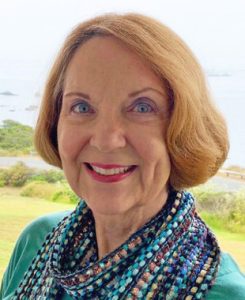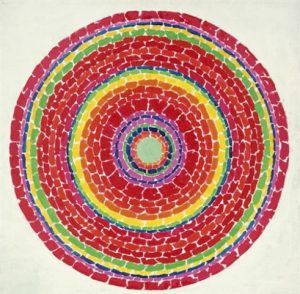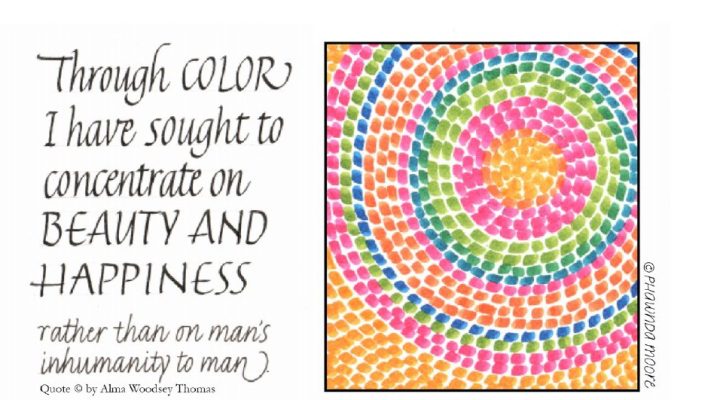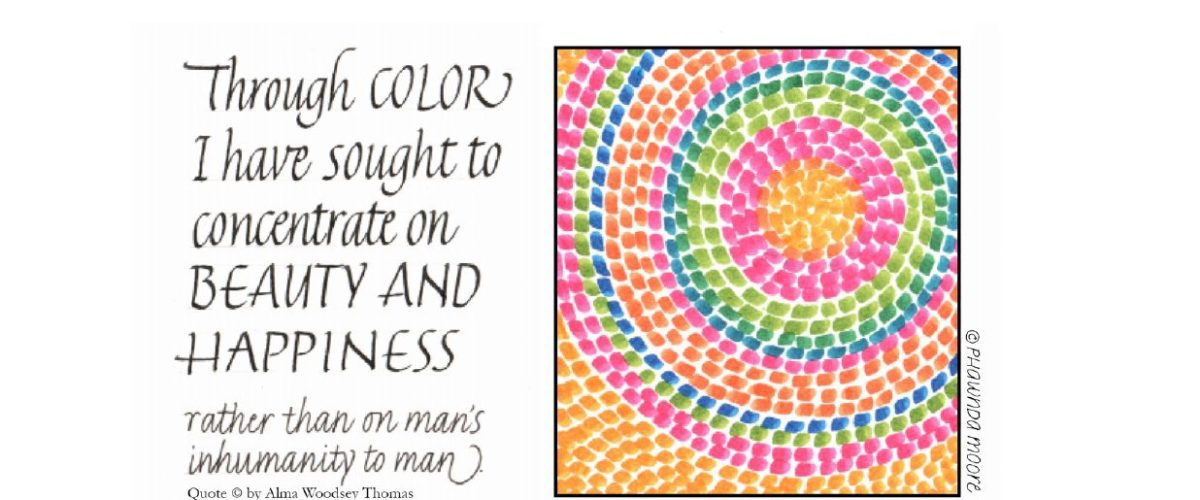Are you searching for new skills needed to navigate life these days? The familiar paths were linear and logical, and too often, they go nowhere.
Many feel they’re walking a labyrinth in the shadows. Imagine that circular shape and come along with me, wherever you are in your day. It won’t take long and has important benefits. The goal is to get beyond ugliness and the irrational and restore a new sense of balance, respect and purpose to these uncertain days.

Phawnda Moore
Let’s walk together in a slow, intentional pace. Focusing on each step, aware of our breathing, we silently visualize peaceful images: waterfalls, a soaring seagull, sunlight-dappled gardens. We keep walking. Thoughts and feelings surface. After a time, we feel connected to the universe, naturally restored human beings.
Folks have been known to repeat this meditative practice, again and again. They say it leads to much-needed spiritual healing and renewal.
Creative personalities who are willing to explore new possibilities with their traits of curiosity, observation and resilience seem to have an advantage here. They’re accomplished at finding meaning in contradictions and chaos because they welcome solitude and allow their minds to wander. Charles Darwin took daily walks in England with his dog on a trail he named his “thinking path.”
This is where some bow out saying, “But I’m just not creative.” You might be surprised at the 18 things they do differently. Carolyn Gregoire, author of this well-received article, co-wrote a great book based on scientific research.
Another trait creative folks have is that they surround themselves with beauty. Yes, even when life is not “normal.” They bring flowers to the table, photograph stunning sights at national parks, linger to watch the sun rise and set, and move to music that speaks to their spirit.
“We can learn from those who’ve lived through the dark seasons of pain, hate and war — yet somehow found beauty in ashes and voiced praise instead of despair.”
We can learn from those who’ve lived through the dark seasons of pain, hate and war — yet somehow found beauty in ashes and voiced praise instead of despair. Many recite the words in Isaiah 61:3 each day to lift their heavy spirits, reaffirm their God-given purpose and stay on its stepping stones.
An inspiring example is Black artist Alma Woodsey Thomas (1891-1978), who lived in the South during racial unrest. The family experienced discrimination and violence in Columbus, Ga., and after her father had an encounter with a lynch mob, they moved to less-segregated Washington, D.C. In the 1970s, Thomas wrote, “At least Washington’s libraries were open to Negroes, whereas Columbus excluded Negroes from its only library.”

“Iris, Tulips, Jonquils, and Crocuses,” Alma Woodsey Thomas
A devoted teacher for 35 years in Washington, D.C., she empowered Black art students to see beauty in each day and brought exhibition opportunities and cultural enrichment to them. Thomas believed creativity should be independent of gender or race and created works from accidental beauty and the abstraction of color.
When she was in her late 60s and had retired from teaching, her painting style became more defined. In 1963, she walked in the March on Washington with her friend, the opera singer Lillian Evans. Although Thomas was largely an apolitical artist, she portrayed the event in a 1964 painting, a section of which became a 2005 U.S. postage stamp.
Her first retrospective exhibit was in 1966 at the Gallery of Art at Howard University, her alma mater. It included 34 works created from 1959 to 1966. For this exhibition, she created Earth Paintings, a series of nature-inspired abstract works, including Resurrection (1966), which in 2014 would be bought for the White House collection.
Thomas began her second major theme of paintings with the moon landing in 1969. The series Space, Snoopy and Earth employed a technique called pointillism, tiny dots of color placed next to each other. She evoked mood with dramatic contrasts of color in a mosaic style, using dark blue against pale pink and orange colors. Folks say her paintings just make them feel happy.

“Springtime in Washington,” Alma Woodsey Thomas
She often paints in circles, a shape that symbolizes wholeness and unity in many cultures. One feels her steadfast dedication in stepping aside from the painful reality of the day, to do what she was called to do. While many Black artists were creating art as a racial protest, Thomas chose a different path: “Through color I have sought to concentrate on beauty and happiness instead of man’s inhumanity to man,” she said.
Alma Woodsey Thomas is now recognized as a major American painter of the 20th century and is well-known internationally. Her paintings sell for upward of $2 million.
Currently, in her hometown in Georgia, two exhibitions opened July 1: the traveling exhibit of her art and a complementary exhibition of the times when the Thomas family lived in the area.
The landmark art exhibition Alma W. Thomas: Everything is Beautiful runs at the Columbus Museum through Sept. 25.
The complementary exhibition, Sand Unshaken: The Origin Story of Alma Thomas, “seeks to challenge traditional myths about Thomas’s upbringing while spotlighting the achievements and challenges of an African American family in the Deep South between Reconstruction and World War I.

“Starry Night and the Astronauts,” Alma Woodsey Thomas
The project draws heavily from Thomas and Cantey family archives in The Columbus Museum’s permanent collection. Featured artifacts include family portraits, books and musical instruments used by family members, furnishings from the Thomas family home in Rose Hill, and a locket purchased by Thomas’ grandfather for her grandmother while both were enslaved.” Sand Unshaken runs through Oct. 2.
Virtual travelers can see Everything Is Beautiful in a 360-degree online tour at The Phillips Collection in Washington, D.C.
An excellent article captures the essence of Thomas’ 2021 exhibition at the Chrysler Museum of Art in Norfolk, Va. Co-curator Seth Feman notes that viewers were “seeking solace and finding encouragement and refocusing their energies on what lies ahead” and that, “Without a doubt, beauty is necessary for the work of making the world a better place.”
Take some time to linger with Alma Woodsey Thomas’ kaleidoscope-like art. Not only will it bring beauty to your day, you also might find yourself walking, meditating on a path that leads to more clarity in this unpredictable world.
“Encountering beauty brings hope,” says pastel artist Alain Picard.
Then, reset who we are (again) and what we believe in. Think creatively to raise the bar above the loud, offensive, dramatic crowds. Speak up in your own language, be it with a brush, a pen, a song.
“Fight for the things that you care about, but do it in a way that will lead others to join you,” Ruth Bader Ginsburg said.
Phawnda Moore is a Northern California artist and award-winning author of Lettering from A to Z: 12 Styles & Awesome Projects for a Creative Life. In living a creative life, she shares spiritual insights from traveling, gardening and cooking. Find her on Facebook at Calligraphy & Design by Phawnda and on Instagram at phawnda.moore.
Related articles:
Creative hands and artistic activism in times of crisis | Opinion by Phawnda Moore
Of wonders and wounds, cloister gardens and chasmic Christianity | Opinion by Rick Pidcock
Q&A with Daniel Bonnell on conveying the sacred in modern art


